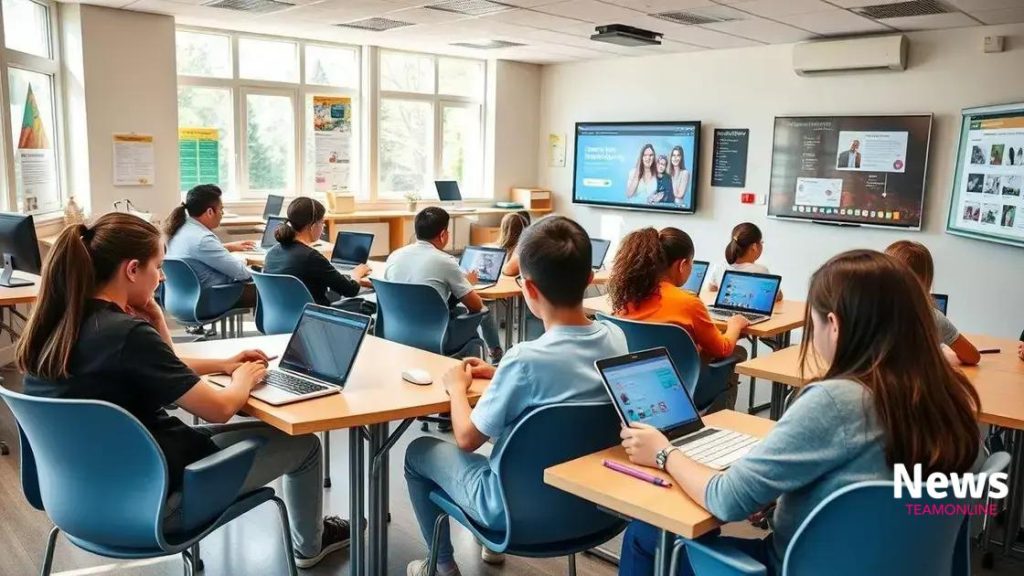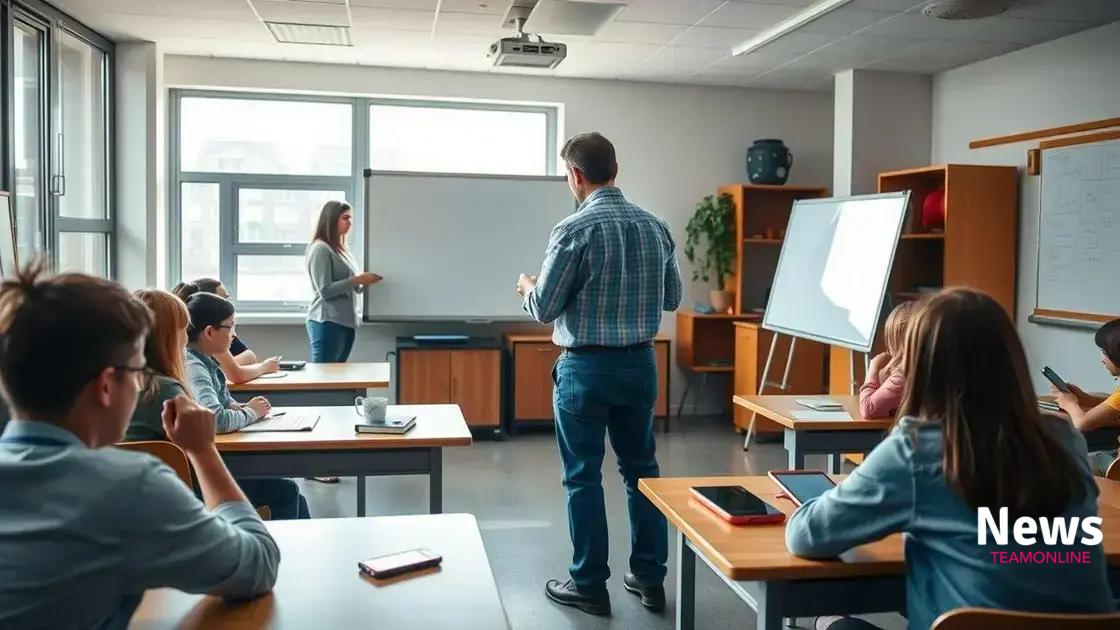Reforms in blended learning for K-12 education

Reforms in blended learning for K-12 education combine traditional and digital methods to enhance student engagement, personalize learning, and prepare students for the future through technology integration and adaptive strategies.
Reforms in blended learning for K-12 education are reshaping classrooms everywhere. Have you noticed how technology is making learning more interactive? Let’s dive into the shifts that are taking place and what they mean for students and teachers alike.
understanding blended learning: what it is
Understanding blended learning is essential in today’s educational landscape. This innovative approach combines traditional classroom methods with digital tools. By merging the best of both worlds, it creates a flexible learning environment that can adapt to the needs of different students.
Blended learning offers various models, which can be tailored to fit school objectives. Schools can choose from several formats to enhance learning experiences. Here are some popular models:
Common Blended Learning Models
- Rotation Model: Students rotate between in-person classes and online learning.
- Flex Model: Online learning is central, with teachers providing support as needed.
- Enriched Virtual Model: Primarily online learning with occasional face-to-face meetings.
Each model allows personalization, ensuring students receive the attention they need to thrive. Teachers can also adapt their teaching methods based on students’ responses and progress. This approach fosters an interactive learning atmosphere.
Moreover, the incorporation of technology in the classroom promotes engagement. Students often feel more connected to their learning when using tools they are familiar with. Online resources can enhance the curriculum, making lessons more dynamic and interesting.
Through blended learning, schools can address various learning styles. For instance, visual learners benefit from video content, while auditory learners may prefer podcasts. This flexibility ensures that all students can participate actively in their education.
key benefits of blended learning in schools
Blended learning in schools offers many benefits for both students and teachers. This educational approach mixes online and traditional face-to-face instruction. By doing this, it creates an environment that enhances learning and motivates students.
One major advantage is the flexibility it provides. Students can learn at their own pace, allowing them to spend more time on challenging subjects. This makes it easier to grasp complex concepts and increases overall understanding.
Increased Engagement
With blended learning, students often show greater engagement. They interact with digital tools, which makes learning more enjoyable. When lessons incorporate videos, games, or interactive quizzes, students are more likely to stay focused and interested.
- Personalized Learning: Each student can customize their learning journey, choosing resources that suit their needs.
- Access to Resources: Online platforms allow students to access a wealth of information beyond textbooks.
- Improved Collaboration: Students can collaborate with peers through online forums and group projects.
Moreover, teachers benefit as well. They can gather data on student performance through sophisticated tracking tools. This helps them identify areas where students struggle and adjust their teaching methods accordingly.
The continuous feedback loop created by blended learning ensures that students receive timely support. With real-time analytics, educators can intervene quickly when a student is falling behind. This can lead to better retention of information and improved academic performance.
challenges in implementing blended learning

Implementing blended learning comes with its own set of challenges. While this educational approach offers many advantages, it demands careful planning and execution to be effective.
One significant hurdle is ensuring that all students have access to the necessary technology. In some cases, there may be a digital divide, where not all students possess a reliable device or internet connection at home. This can create inequalities in learning opportunities, limiting some students from fully participating in blended programs.
Training and Support for Teachers
Another challenge involves providing adequate training for teachers. Many educators may not be familiar with technology or may feel overwhelmed by new digital tools. Effective professional development is crucial to help teachers feel confident in using blended learning models.
- Time Constraints: Teachers often have limited time to adapt lesson plans for mixed delivery methods.
- Resistance to Change: Some educators may prefer traditional teaching methods and resist transitioning to blended learning.
- Maintaining Engagement: Keeping students engaged in both in-person and online settings can be difficult.
Moreover, blending different learning environments requires a clear curriculum design. It’s important that lessons not only integrate technology but also extend the educational goals of in-person classes. Poor integration can lead to confusion among students and disrupt the learning process.
Feedback and assessment methods also pose challenges. Teachers need to find effective ways to evaluate student performance in both the classroom and online settings. Balancing these assessments can be complex, as traditional grading may not accurately reflect a student’s mastery of the content.
successful case studies of blended learning
There are various successful case studies that showcase the effectiveness of blended learning in schools. These examples illustrate how schools can successfully integrate this model and enhance student engagement and learning outcomes.
One notable case is the Florida Virtual School. This online school combines virtual courses with traditional classroom experiences. It allows students to participate in a flexible learning environment tailored to their needs. Students can pursue online classes while attending in-person sessions as required. The results have shown increased graduation rates and higher student satisfaction.
Innovative Approaches in Schools
Another successful implementation is seen in many districts in California. By using the blended learning model, they provide students with various learning paths. Teachers use technology to support personalized learning, ensuring that students can engage with the material in ways that suit their learning styles.
- Real-Time Feedback: Technology allows students to receive instant feedback, promoting quicker understanding of concepts.
- Increased Collaboration: Students in California utilize online forums to discuss class material and collaborate on projects.
- Accessibility: Online resources allow students to access learning materials anytime, anywhere.
In addition, the Khan Academy has proven effective in numerous schools. This platform allows teachers to assign specific lessons based on each student’s needs. They can track progress and adjust instruction accordingly. The use of Khan Academy has led to noticeable improvements in student performance and confidence.
Overall, these success stories emphasize how blending traditional and online learning can produce remarkable results. As schools continue to adopt and adapt these models, it is essential to learn from these case studies and apply best practices.
future trends in K-12 blended learning
The future of K-12 blended learning is bright and full of exciting possibilities. As technology continues to evolve, we can expect significant advancements in how education is delivered.
One key trend is the rise of adaptive learning technologies. These tools can analyze student data in real-time, allowing for personalized learning experiences. Each student can receive tailored content based on their unique needs and learning pace, making education more effective.
Increased Use of Artificial Intelligence
Artificial Intelligence (AI) will play a major role in blended learning. It can help automate administrative tasks for teachers, giving them more time to focus on instruction. AI-powered tutoring systems will assist students outside of classroom hours, providing additional support when needed.
- Virtual Reality (VR) and Augmented Reality (AR): These technologies are set to enhance interactive learning experiences. Students can explore historical sites or science phenomena in immersive ways.
- Data-Driven Insights: Schools will increasingly rely on data analytics to make decisions about curriculum and teaching methods based on student success rates.
- Global Learning Environments: Thanks to online platforms, students can connect with peers from around the world, collaborating on projects and sharing cultural experiences.
Moreover, the importance of social emotional learning (SEL) will grow. Blended learning environments will incorporate SEL practices to support student well-being alongside academic achievement. This holistic approach will help students develop essential life skills.
Finally, the shift towards lifelong learning will change how blended learning is viewed. Education will not be confined to the classroom, but rather a continuous journey of growth and development throughout life.
In conclusion, blended learning represents a transformative approach in K-12 education. It combines traditional and digital teaching methods to create more engaging and personalized learning experiences. As we look ahead, the integration of advanced technologies like AI and VR will further enhance this educational model. Understanding the benefits and challenges of blended learning can help educators effectively implement it in their classrooms. By adapting to these changes, schools can better prepare students for their futures and provide more inclusive educational opportunities.
FAQ – Frequently Asked Questions about Blended Learning in K-12 Education
What is blended learning?
Blended learning combines traditional classroom teaching with online digital resources, allowing for a more personalized learning experience.
How does blended learning benefit students?
Blended learning increases student engagement, provides flexible learning options, and allows for personalized pacing based on individual needs.
What challenges might schools face when implementing blended learning?
Schools may encounter challenges like ensuring access to technology, providing sufficient teacher training, and maintaining student engagement.
What are some future trends in blended learning?
Future trends include the adoption of AI and VR technologies, increased focus on social emotional learning, and a shift towards lifelong learning strategies.





